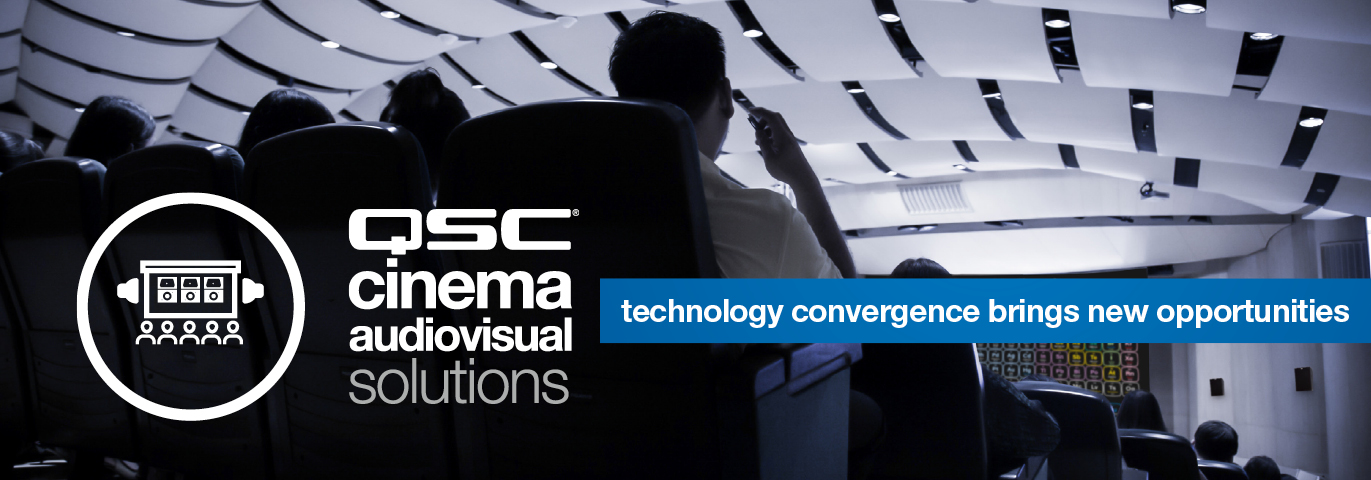Technology Convergence Brings New Opportunities
Q: When is a movie theatre not a movie theatre?
A: When the content appears to be feature film or custom created content, but you don’t smell popcorn as you walk in, and you didn’t have to buy a ticket.
The venue might be a high school or college auditorium, a community center, a museum, or a showroom on a cruise ship. The space doesn’t look like a movie theatre, because that’s not its main purpose. The technology may be more akin to “AV” than “Cinema” (think Blu-ray disc player, not an integrated media block), yet, the intent is to show non-DCI content with “cinema-like” presentation quality.
This is the idea behind QSC’s Cinema Audiovisual Solutions program. It’s an intentional but controlled effort to cross-market technologies to end-customers who want the best of both worlds. It’s products designed for use in movie theatres being used in non-Cinema applications.
Why are we doing this?
In the AV world, the one trend overshadowing all others, for almost two decades, has been the convergence of AV and IT. I first wrote about it back in 2003 for a publication called Pro AV magazine. In my editorial, I called “convergence” an overused term (even back then!), and wrote:
“…it’s probably time to retire that word because it implies ‘the act of converging,’ and it’s pretty clear now that the act may never really conclude. The new state of the (AV) industry may never be fully resolved into a static, singularly definable one. If there is one immutable characteristic describing what we’re about, it’s that we use technology tools that involve multiple human senses to achieve communication. For now, the tools primarily address the visual and auditory senses, and so we are all ‘AV professionals’ to some extent.”
Seventeen years later, that convergence continues, and extends to yet another group of AV professionals: those of us in the Cinema technology business. As digital technologies pervade nearly every facet of what we do, the lines between what we once thought to be discrete markets are being blurred. Virtually all content is created, stored, and delivered digitally. The technologies to do so, whether IT, AV, or Cinema are far more alike today than back in the days of mainframes and terminals, overhead projectors, and discrete motion picture frames on celluloid film. It’s all digital and it’s all networked. The major differences lie in how systems are designed and installed.

In a similar way that telephones, televisions, and computers have converged, it seems that AV, Cinema, and IT technologies are headed on the same path. But it’s important to acknowledge that while the technologies may converge, the markets and industries that serve them do not necessarily converge. There are different end-user outcomes for each: AV is generally used to communicate, Cinema is primarily an art form used to entertain, and IT is essential for business applications, as well as serving as the technology backbone that supports everything (AV, Cinema, television, telephony, and just about every other technology application). There are sufficient differences among all of these applications that require specialized expertise and knowledge to properly address and support each one individually.
I think of technology convergences as “asymptotic lines” that bend closer and closer together over time, but never quite merge into one. In practical terms, that means that while technologies and markets may move closer together and share technologies, it doesn’t mean one will absorb another. It simply means a sharing of technologies and markets toward the goal of maximizing opportunities for technology providers and the quality of experience for technology users.
What do you think? Let us know in the section below if this “convergence” has affected your business and how you are adapting to it.

734325 534557Thank you for sharing with us, I conceive this site truly stands out : D. 28752
59982 582391Does your blog have a contact page? Im having a tough time locating it but, Id like to send you an e-mail. Ive got some suggestions for your weblog you might be interested in hearing. Either way, fantastic website and I look forward to seeing it expand over time. 442393
5904 995408Have you noticed the news has changed its approach recently? What used to neve be brought up or discussed has changed. Its that time to chagnge our stance on this though. 705361
190292 872988Deference to op , some superb entropy. 74774
139414 530970I saw plenty of web site but I believe this 1 has got something special in it in it 876101
569730 927880Wonderful post, I conceive site owners need to larn a good deal from this internet site its quite user friendly . 727647
Статья содержит информацию, которую можно применить в практической деятельности.
Автор статьи предоставляет факты и аргументы, не влияя на читателя своими собственными предпочтениями или предвзятостью.
canadian drugs pharmacies online